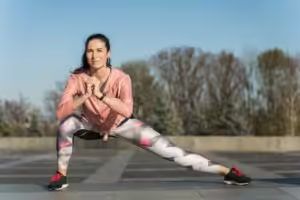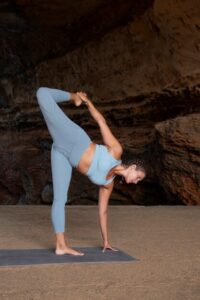
Yoga has long been celebrated as one of the most effective holistic practices, supplying benefits that span across physical, mental, and spiritual well-being. however, complete-body yoga—when practiced efficaciously—can take your wellbeing journey to the next stage, concentrated on each a part of your body from head to toe. whether you are a beginner or a skilled yogi, incorporating full-frame yoga into your routine will let you achieve power, flexibility, and internal balance. in this final manual, we’ll walk you thru the essentials of mastering complete-frame yoga.
1. Understanding complete-frame Yoga
full-body yoga focuses on enticing every muscle institution, enhancing mobility, and improving posture whilst calming the thoughts. in contrast to yoga styles that target particular regions just like the middle or legs, full-frame yoga routines involve synchronized movements that set off a couple of elements of the frame concurrently. This complete method leads to greater strength and persistence, more suitable flexibility, and an extra-profound mind-body connection.
2. blessings of complete-frame Yoga
Incorporating complete-frame yoga into your day-to-day exercise can yield an extensive variety of advantages:
Progressed Flexibility: normal stretching and flow movements boom the ability of your muscular tissues and joints.
Multiplied electricity: full-frame sequences build energy to your hands, legs, center, and back.
Enhanced stability and coordination: The aware transitions between poses enhance your balance and spatial attention.
strain discount: Yoga’s attention on breathwork and mindfulness enables calming the thoughts and decreasing stress.
increased power ranges: The fluid actions and deep breathing stimulate circulation, leading to a lift in power.
3. critical Poses for full-frame Yoga
To create a complete full-frame yoga routine, you must include a variety of poses that target unique muscle groups. right here are some of the excellent poses to include:
a. Mountain Pose (Tadasana)
Mountain pose is a grounding posture that helps align the body and prepares it for motion. Stand tall together with your toes together, hands at your facets, and attention on elongating your backbone. This pose strengthens your legs, improves posture, and complements universal frame focus.

b. Downward-facing canine (Adho Mukha Svanasana)
one of the most iconic yoga poses, Downward canine works your shoulders, hands, hamstrings, and calves at the same time as also stretching the backbone. This pose encourages full-body activation and is perfect for constructing upper-frame electricity.
c. Plank Pose (Phalakasana)
Plank pose is a powerhouse circulate for full-frame power. It strengthens your hands, center, again, and legs. keeping this pose calls for enticing multiple muscular tissues straight away, making it a remarkable addition to your complete-frame habitual.
d. Warrior II (Virabhadrasana II)
Warrior II focuses on your legs, hips, and shoulders. This pose promotes stability, strengthens the lower body, and opens up the hips and chest, making it a critical part of any full-body yoga session.
e. Bridge Pose (Setu Bandhasana)
This pose stretches the chest, neck, and spine at the same time as strengthening the glutes and hamstrings and decreasing the lower back. It enables improved posture and stimulates the belly organs.
f. Tree Pose (Vrksasana)
Tree pose is excellent for improving stability and attention. standing on one leg with the other foot placed at the inner thigh, this pose works to your middle, legs, and standard stability.

g. toddler’s Pose (Balasana)
baby’s Pose is a restorative pose that stretches the hips, thighs, and ankles. It additionally facilitates relieve anxiety inside the back and shoulders, selling relaxation and mindfulness.
4. building a complete-frame Yoga habitual
growing a nicely-rounded complete-frame yoga collection calls for attention to stability, float, and breathwork. here’s a sample recurring to guide your practice:
1. heat-Up:
– start with five minutes of deep respiration (Pranayama) and mild stretches to warm up the muscle tissues.
2. solar Salutations (Surya Namaskar):
Perform five rounds of solar salutations to have interaction with the entire body and growth blood flow.
3. predominant waft
:
Transition through Mountain Pose, Downward Dog, Plank Pose, Warrior II, and Bridge Pose. maintain each pose for 3-5 breaths to construct strength and versatility.
4. Balancing collection:
– incorporate balancing poses like Tree Pose to paintings on balance and attention.
5. calm down:
– end with seated ahead bends or spinal twists to release tension in the backbone, observed by way of toddler’s Pose for rest.
6. Savasana (Corpse Pose):
– quit with five-10 minutes of Savasana to loosen up the frame and mind, permitting all the blessings of your exercise to settle in.

5. Breathwork and Mindfulness in complete-frame Yoga
one of the most crucial components of full-frame yoga is breathwork, additionally referred to as Pranayama. Deep, managed respiratory enables oxygenate the muscles, decorate flexibility, and create a peaceful, focused mind. at the same time as shifting via each pose, cognizance on synchronizing your breath with your actions. as an instance, inhale while extending or achieving, and exhale as you fold or agree. This aware breathing allows you to deepen your exercise and allows you to stay present.
6. changes and modifications
anybody is specific, and full-frame yoga can be tailored to match character needs. if you’re a novice or going through any physical limitations, bear in mind the use of props consisting of yoga blocks, straps, or bolsters to support your exercise. This equipment helps hold the right alignment and saves you pressure or injury. moreover, pay attention to your body and never pressure yourself into poses that feel uncomfortable or painful.
7. suggestions for Maximizing Your exercise
To get the maximum from your complete-frame yoga practice, don’t forget the subsequent suggestions:
Consistency: Exercise regularly to look for enhancements in electricity, flexibility, and mindfulness.
Aware ingesting: integrate your yoga habitual with a wholesome diet to gasoline your frame for ideal performance.
Hydration: Maintain yourself hydrated before and after your yoga consultation to support muscle recovery.
Set dreams: whether or not it’s improving your flexibility or protecting a difficult pose, setting unique goals will keep you motivated.
8. conclusion
full-body yoga is a transformative exercise that engages each part of your being. By incorporating an expansion of poses, breathwork, and mindfulness into your ordinary, you can enjoy a profound sense of balance, energy, and internal peace. whether or not you’re looking for bodily fitness, intellectual readability, or non-secular increase, full-frame yoga is the remaining pathway to accomplishing total well-being.
begin your adventure nowadays, and don’t forget—yoga is not about perfection but development. embody the technique, and revel in the lifelong benefits of a regular complete-body yoga practice!
